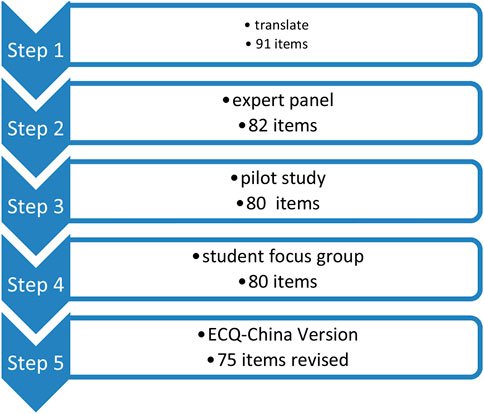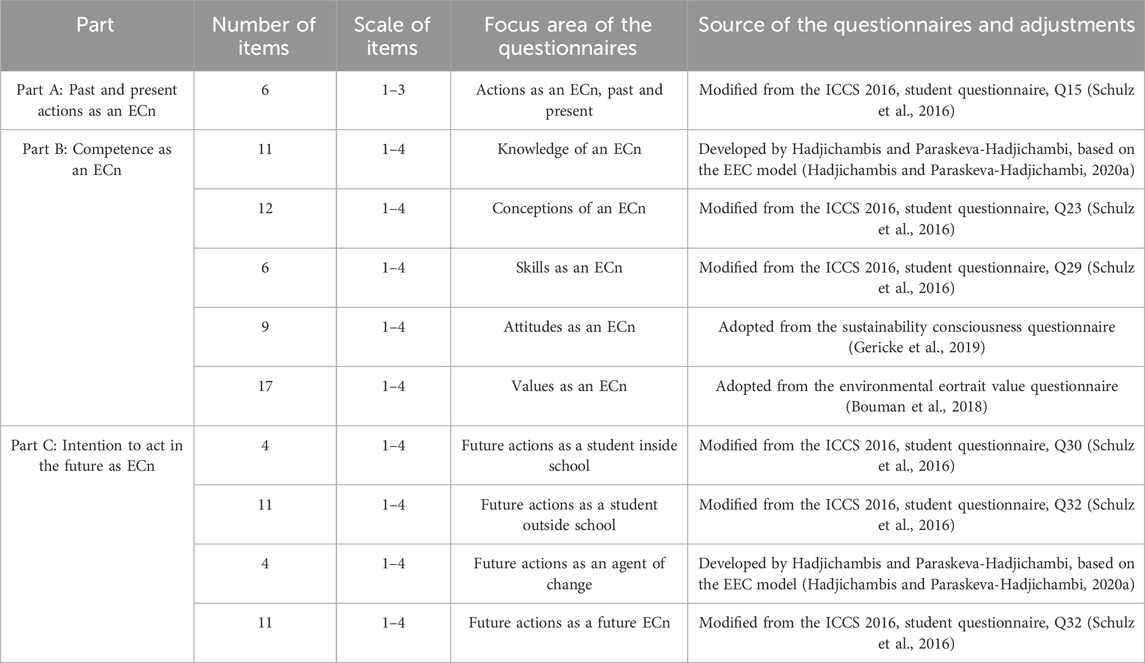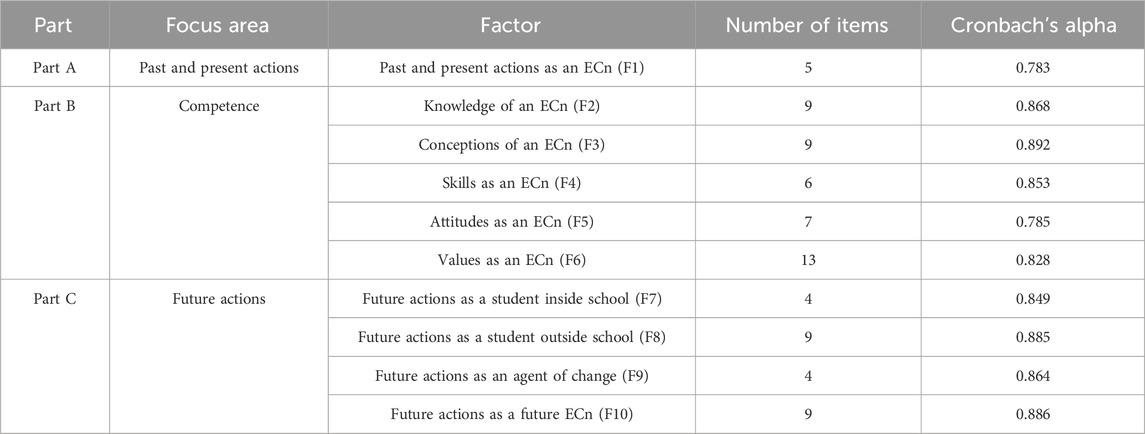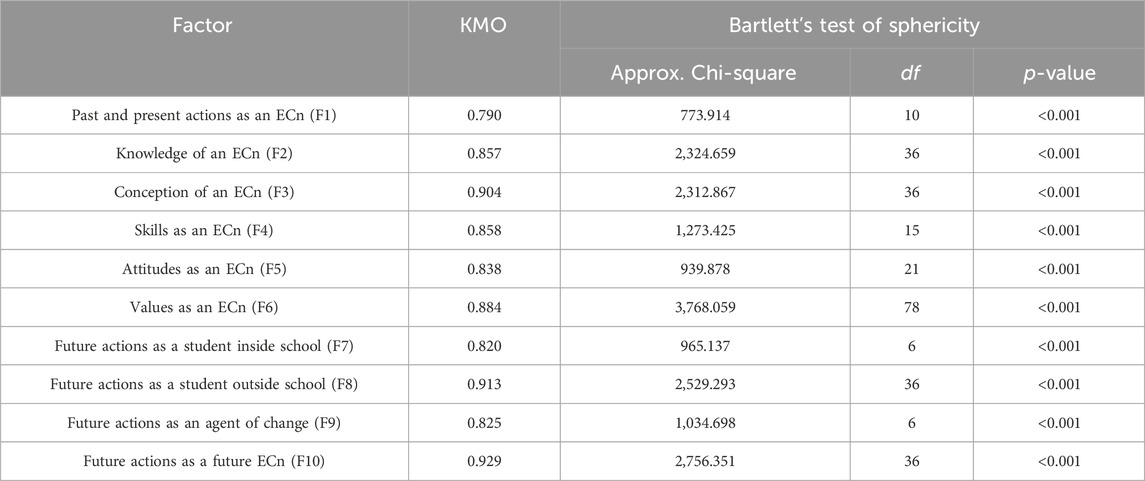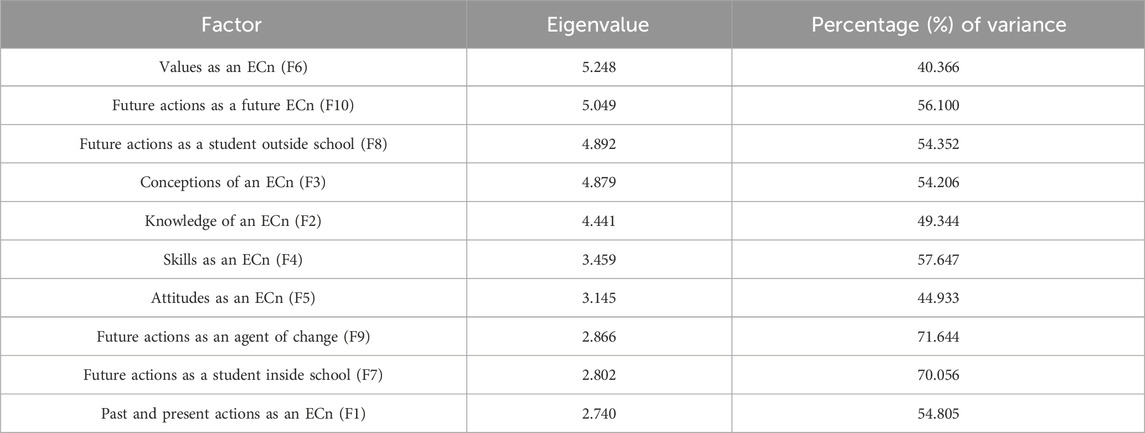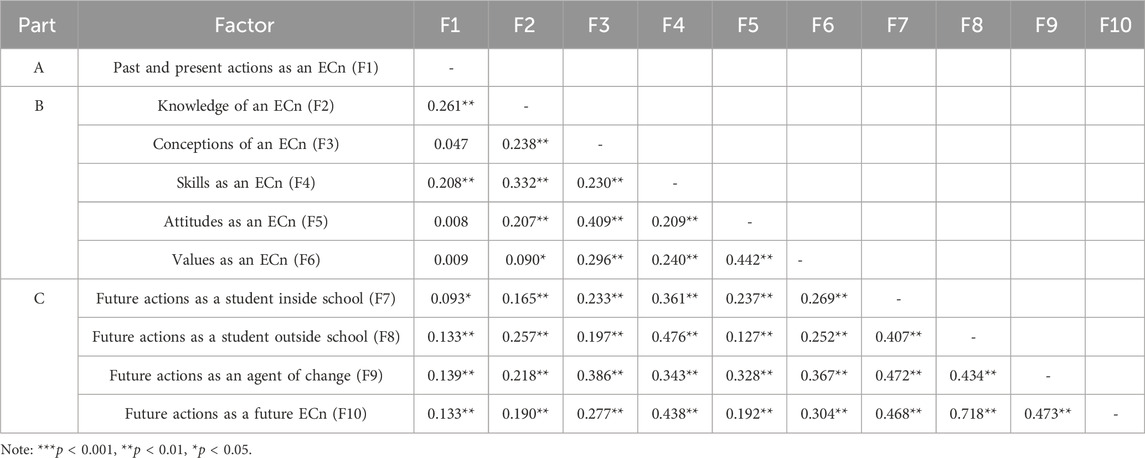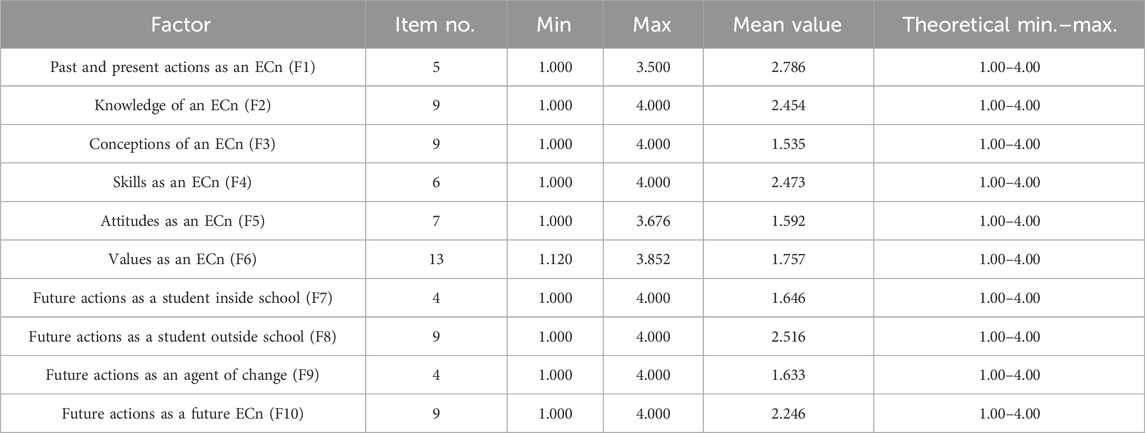- 1School of Law, Central South University, Changsha, China
- 2School of Humanities and Juvenile and Family Law Research Center, Jinan University, Zhuhai, China
The cultivation of environmental citizens has become an important measure to cope with the environmental crisis, and the research on the knowledge, conceptions, skills, attitudes, values, and actions of environmental citizens using the Environmental Citizenship Questionnaire (ECQ) is becoming a research focus. The research on environmental citizenship in China mainly staying at the level of theoretical research and descriptive research due to the accuracy of the ECQ. The emergence of the ECQ-China Version is helpful to promote the empirical research on environmental citizenship in China.This study verifies the effectiveness of the ECQ by removing 16 ECQ items which are not suitable for Chinese culture and evaluating environmental citizen-related knowledge among 550 Chinese junior high school students. The ECQ-China Version, consisting of 75 items, showed convincing results for all measurements: students’ past and present environmental citizenship behavior and the essential skills, values, attitudes, and competence that an environmental citizen should be equipped with had a significant impact on students’ future environmental citizenship behavior. This study suggests that: (1) Environmental citizenship education should not only focus on knowledge education, but also include skills education. (2) Environmental citizenship education should adhere to comprehensive principles, focusing on innovative practice of ideas and methods. (3) China’s environmental citizenship education should focus on the cultivation of citizens’ ability to participate, so that environmental citizenship can become the driving force for sustainable environmental development.
1 Introduction
The study of environmental citizenship in China began in this century, with few statistical results available (Liu et al., 2020; Mi et al., 2021). Data obtained from the China National Knowledge Infrastructure (CNKI) indicates that environmental citizenship research in China has only existed since 2012, and only six related journal articles exist. As a concept closely related to environmental protection and human development, environmental citizenship can spark citizens’ enthusiasm to participate in environmental protection and contribute to the sustainable development of the environment in the 21st century (Manteaw, 2008). The concept of environmental citizenship is different from the concept of citizenship. Citizenship was originally a political concept that determined the relationship between individuals and the State (Casas-Cortes, 2019; Weinberg and Flinders, 2018). It is easy to distinguish between British citizenship and American citizenship, but it is difficult to define environmental citizenship precisely because it is no longer a purely political matter. So it has been suggested that the concept of environmental citizenship be replaced by being “a citizen of the environment,” thus blurring the concept of environmental citizenship (Bell, 2005). Other researchers believe that the concept of environmental citizenship emphasizes more on citizens’ choice of environment-friendly lifestyle, and also include knowledge, awareness, responsibility, and respect for the environment at both the individual and social levels (Hailwood, 2005; Smederevac-Lalic et al., 2020). While environmental citizenship conceptualizes the relationship between citizens and the environment (Huttunen et al., 2020), the environmental citizenship concept differs from liberal environmental citizenship (Bell, 2005; Fadaee, 2017), corporate environmental citizenship (Özen and Küskü, 2009; Raineri and Paillé, 2016), environmental citizenship responsibility (Aarnio-Linnanvuori, 2019; Vihersalo, 2017), environmental citizenship behavior (Robertson and Barling, 2017; Soleimanpouromran and Ahmadimoghadam, 2021), and organizational environmental citizenship behavior (Khan et al., 2019; Wang, 2022). According to the interpretation of European Network for Environmental Citizenship (ENEC),
“Environmental Citizenship” is defined as the responsible pro-environmental behaviour of citizens who act and participate in society as agents of change in the private and public sphere, on a local, national and global scale, through individual and collective actions, in the direction of solving contemporary environmental problems, preventing the creation of new environmental problems, achieving sustainability as well as developing a healthy relationship with nature. “Environmental Citizenship” includes the exercise of environmental rights and duties, as well as the identification of the underlying structural causes of environmental degradation and environmental problems, the development of the willingness and the competences for critical and active engagement and civic participation to address those structural causes, acting individually and collectively within democratic means, and taking into account inter- and intra-generational justice (ENEC, 2018).
Guided by the concept of environmental citizenship, we should all take responsibility for how we interact with the environment (Asah et al., 2018; Cheema et al., 2020). There are many methods of doing this, including adopting a green lifestyle, participating in environmental decision-making, and holding businesses to account (Young et al., 2010). To ensure a harmonious relationship between the environment and human beings, we must conduct research on social, behavioral, and environmental citizenship (Dobson, 2007; Vlek and Steg, 2007). The impact of modern consumer-oriented society on the environment is currently endangering living standards and is nearing the threshold of the Earth’s carrying capacity (Sodip et al., 2019; Uckan Yuksel and Kaya, 2021). The environmental citizenship concept closely links human activities with sustainable environment development, and the Education for Environmental Citizenship (EEC) is considered a means of achieving such development (Cheah and Huang, 2019; Parra et al., 2020). The goal of EEC is to facilitate the commitment toward and the capacity for active participation in environmentally responsible actions (Goldman et al., 2020).
The extant environmental citizenship research believes that youth citizenship education contributes to environmental sustainability. Simultaneously, it is convinced that responsible environmental behavior and attitudes are critical for environmental protection. Therefore, the purpose of EEC should be to cultivate environmentally-friendly citizens through education, thus EEC is the main focus of the current research. EEC is a type of citizenship education that plays a key role in shaping future environmental citizens (Hadjichambis and Paraskeva-Hadjichambi, 2020a). Although EEC is an emerging educational field, it has already formed a systematical pedagogical landscape (Ariza et al., 2021). In China, the implementation of EEC is conducted according to the following logical structure. First, to recognize the current situation that the environment is being destroyed, and to cultivate awareness of environmental protection (Kirkpatrick and Zang, 2011; Kong et al., 2020; Zhao et al., 2020). Second, to make students realize that protecting the environment is their responsibility from the perspective of citizens’ rights and obligations (Yang and Calhoun, 2007; Fu and Liu, 2017; Liao and Li, 2019; Xiang et al., 2019). Finally, to understand that environmental protection from the sustainable development perspective should aim at intergenerational development (Hu et al., 2020; Zhang, 2018). Based on these points, the Chinese government has proposed “the civic political concept that lucid waters and lush mountains are invaluable assets” (Pan, 2021). The implementation of EEC in China is essentially consistent with the European Network for Environmental Citizenship’s (ENEC) requirements for EEC (ENEC, 2018).
Environmental education has been around since the 1970s and has promoted the cultivation of environmentally conscious citizens as the solution to environmental problems (Ariza et al., 2021; Schild, 2016). Previous researchers have developed the EEC model based on its pedagogical landscape and definition. The EEC model identifies eight outcomes (orange arrows) and can explain environmental education from two dimensions: actions and spheres; that is, individual and collective actions, and public and private spheres (black arrows). The EEC model should be explained at the local, national, and global scales. Although the EEC model includes various factors, such as actions, spheres, and scales, it does not describe the relationship between these factors. The EEC model explains the concept of environmental citizenship education very well.
In order to enrich the theoretical and practical research of environmental citizenship, researchers began to develop a systematic Environmental Citizenship Questionnaire (ECQ). Since the study of environmental citizenship should not only focus on the concept of environmental citizenship, but also include the behaviors of environmental citizens in the past and the future, the researchers designed the ECQ based on the combination and modification of the existing research scale. In the development of the ECQ, the following factors should be specifically considered: (1) taking responsibility for individual behavior and the impact one has on the global and local environment, (2) knowledge and skills for environmental decision making, and taking action; (3) intergenerational sustainably, the idea that the future generations will live better (Dobson, 2007; Olsen et al., 2020).
Finally, the researchers development the ECQ on the basis of the International Civic and Citizenship Education Study (ICCS) Scale, the Sustainability Consciousness Questionnaire (SCQ), and the Environmental Portrait Value Questionnaire (E-PVQ) (Schulz et al., 2016; Gericke et al., 2019; Bouman et al., 2018). Then, the ECQ has been improved based on the EEC model. The ECQ includes six evaluation indicators (green circle) that an environmental citizen (ECn) should possess. According to Hadjichambis and Paraskeva-Hadjichambi (2020a), EEC includes eight pedagogical methods that work together to achieve environmental citizenship (Hadjichambis and Paraskeva-Hadjichambi, 2020b). According to the ENEC (2018), the purpose of EEC is to educate citizens in mastering the skills, values, attitudes, and abilities required to participate in the governance of an environment-friendly society, so as to solve modern environmental problems, prevent environmental problems, and achieve environmentally sustainable development.
Although the concept of environmental citizenship has been theorized, it does not address the specific ways in which environmental citizenship is cultivated (Hadjichambis and Reis, 2020; Schild, 2016; Schindel Dimick, 2015). In order to improve the effectiveness and applicability of ECQ, researchers have improved the ECQ based on the EEC model and the ICCS Scale (Hadjichambis and Paraskeva-Hadjichambi, 2020b; Schulz et al., 2016). The extant environmental citizenship education research in China reveals that the ECQ has the following characteristics. First, it combines environmental education with law to emphasize that environmentally destructive behavior is illegal (Li et al., 2019). Second, it places importance on the cultivation of environmental citizenship behavior as quality education content, and requires students to learn garbage classification skills (Gong et al., 2020). Third, it encourages students to participate in social practice activities (Wang et al., 2021). The ECQ has been verified and confirmed in different countries and has good reliability and validity. Accordingly, this study develops the ECQ by analyzing the applicability of the scale in China through qualitative research and revising the scale through quantitative research. In recent years, China’s EEC has made some progress, but scant research in China has focused on the effectiveness of EEC. Therefore, this study aims to both fill this research gap and develop the ECQ to enable it as an important tool for studying environmental citizenship in China.
2 Materials and methods
2.1 Development of the ECQ-China version
This study’s development of the ECQ-China Version was based on both a review of the extant domestic and foreign literature and the ECQ (including 91 items) that is widely used in European countries. The research process included five stages: translation, expert panel, pilot study, student focus group, and item analysis and reliability (Figure 1). During the research process, the researchers translated and deleted items of the ECQ, so the final version (ECQ-China Version) should be interpreted as the translated version of the ECQ. After deleting a small number of items from the ECQ, the scale still had enough items for the researchers to achieve the study purpose, so the researchers did not replace the deleted items; moreover, the final results showed that the ECQ-China Version could be used for research on EEC in China. In the future, based on the ECQ-China Version, the researchers will create new items to replace the removed ones and add new variables according to the current situation of China’s EEC.
2.1.1 Generation of the ECQ’s 91 items: translate
During the development of the ECQ-China Version, this study first conducted a comprehensive literature review to discover the scientific instruments used to evaluate the effectiveness of EEC. This helped the researchers to uncover potential items that could be used in the research on EEC. The first group of items was from the ICCS Scale (Schulz et al., 2016). These items did not directly focus on EEC but were closely related to citizenship education and environmental protection. Based on the ICCS research, this study learned about how adolescents in different countries fulfilled their civic responsibilities. Therefore, this study selected and revised the items closely related to environmental citizenship. The second group of items was developed by Hadjichambis and Paraskeva-Hadjichambi (2020a), based on the EEC model. The third group of items was collected from the Sustainability Consciousness Questionnaire (SCQ) (Gericke et al., 2019). During this phase, the researchers added nine items related to attitudes toward sustainable development to the ECQ. The fourth group of items was extracted from the Environmental Portrait Value Questionnaire (E-PVQ), which included 17 items related to environmental values (Bouman et al., 2018). The above four groups of items were translated into Chinese to meet the reading comprehension of junior high school students. Ultimately, this study developed a 91-items scale based on the EEC model, which could be divided into three parts according to the content and purpose of the study: past and present actions (Part A), competence (Part B), and intention (Part C). All parts relate to an ECn. The sources of the 91 items and their focus areas are presented in Table 1.
2.1.2 Expert panel
The initial 91 items (Supplementary Material) were reviewed by an expert panel comprising of two university researchers and two Chinese junior high school teachers. The expert panel mainly considered whether the items were suitable for measuring environmental citizenship among junior high school students from the following perspectives: reading habits, professional terminology, comprehension ability, and content validity. This process resulted in the deletion of nine items (1b, 3h,3i,3j, 5h, 6f, 6h, 6j, and 6i), which formed the first version of the ECQ (82 items).
2.1.3 Pilot study
The first version of the ECQ was then piloted with 62 junior high school students (9th grade), and two Chinese junior high school teachers were responsible for the classes. The students and teachers were asked to mark any errors, incomprehensible words, or terms. Based on the feedback, incorrect or inappropriate words were revised in the ECQ. During this step, two items (2f and 2h) were removed from the ECQ, and no other items were added.
2.1.4 Student focus group
In addition to the pilot study, this study surveyed students aged 14–15 years and conducted focus group discussions with two groups of 8th grade students to determine whether the 85 items were consistent with real-life situations and language habits. There are 18 14-aged and 16 15-aged students, with a total number of 34. During this process, this study did not add or delete any items, but adjusted the language habits of some items.
2.1.5 ECQ sample
This study was conducted in representative city in a central China that specifically reflected economic development status, education implementation level, demographic characteristics, residents’ consumption capacity, and other factors. According to the latest Chinese city tier system, the representative city belongs to a third-tier city. There are 70 cities with similar characteristics in China across 21 provinces covering a population of 349 million people (Wu and Yi, 2022). This study obtained the consent of the local education department, school, teachers, and respondents and their parents, as follows. First, the researchers communicated with the local education department and school to obtain the opportunity to conduct the research. Second, with the help of the teachers, the researchers obtained the consent of the respondents’ parents through telephone communication. Finally, the researchers distributed questionnaires to the students who agreed to participate in the study.
After considering both the school size and whether the textbooks used by students were nationally representative, the local education department recommended four junior high schools. In China, junior high schools include three grades (grades 7–9). To better understand and evaluate the effectiveness of EEC in grade 7 and provide an improvement experience for EEC in grade 9, this study used random sampling to select 8th grade students from the four junior high schools. The school and all participants provided informed consent, and the consent was written. After obtaining consent, this study distributed 620 questionnaires and effectively collected 550 responses (58.2% female, 41.8% male; response rate = 88.71%). The time to complete the questionnaire was about 30 min.
2.2 Item analysis and reliability
According to Burmeister and Aitken (2012), sample size is a crucial factor that influences the validity and clinical relevance of the findings. This study’s sample size (n = 550) was considered very good for performing factor analysis (MacCallum et al., 1999). The following scale of sample size adequacy was used: probably good over 100, good over 300, very good over 500. After reviewing the previous research (Hutabarat et al., 2020; Kyriazos, 2018), this study used a sample size of over 500. Five items (5a, 8i, 8j, 10i, and 10j) were removed from the ECQ-China Version to achieve an adequate Cronbach’s alpha coefficient for each factor, meaning that 75 items remained in the ECQ-China Version, as shown in Figure 1.
3 Results
3.1 Factor analysis
A principal component analysis (PCA) was conducted using confirmatory factor analysis. Data analysis was done by SPSS Statistics 26.0 (IBM). Supplementary Material and Table 2 present the factor loadings of the 75 items of the ECQ-China Version. Only five items showed factor loadings below 0.450 and above 0.392: one in Q1/Factor 1 (Past and present actions as an ECn), one in Q2/Factor 2 (Knowledge of an ECn), one in Q3/Factor 3 (Conceptions of an ECn), and two in Q5/Factor 5 (Attitudes of an ECn). The vast majority (93.333%) of the 75 items showed factor loadings above 0.450, which is considered an acceptable value.
From the reliability analysis of 10 factors (Table 3), Cronbach’s alpha value ranged from 0.783 to 0.892, indicating high reliability in all factors. The following factors had the greatest reliability: Knowledge of an ECn (0.868), Conceptions of an ECn (0.892), Skills as an ECn (0.853), Future actions as a student outside school (0.885), and Future actions as a future ECn (0.886).
3.2 Kaiser–Meyer–Olkin and Bartlett’s test of sphericity
This study used the Kaiser–Meyer–Olkin (KMO) test to examine the strength of the partial correlation (how the factors explain each other) between the variables, as well as Bartlett’s test of sphericity to test the null hypothesis that the correlation matrix was an identity matrix (Natalya and Purwanto, 2018; Shrestha, 2021). KMO values greater than 0.5 are acceptable in factor analysis (Maskey et al., 2018). Hutcheson and Sofroniou (1999) suggest that values above 0.9 are superb, values between 0.8 and 0.9 are great, values between 0.7 and 0.8 are good, and values between 0.5 and 0.7 are acceptable. The KMO values of the factors in this study ranged from 0.790 (F1)–0.929 (F10), which indicated that sufficient items were predicted by each factor in this study (Table 4). Therefore, all the variables were credible for conducting factor analysis. Moreover, Bartlett’s sphericity test was significant, which implied that the correlation matrix was not an identity matrix, thus supporting the factorization of the correlation matrix (Hadi et al., 2016). The KMO and Bartlett’s sphericity tests showed that the data (variables) were suitable for factor analysis.
3.3 Eigenvalues and percentage of variance
All factors had eigenvalues greater than 1, and the percentages of variance were greater than 40% (Table 5). The “Future actions as an agent of change” factor chad the highest value (70.056) while “Values as an ECn” had the lowest value (40.366).
3.4 Correlation between factors
This study used Pearson’s correlation coefficient to examine the possible significant relationships between Part A (F1), Part B (F2, F3, F4, F5, and F6), and Part C (F7, F8, F9, and F10) of the ECQ (Table 6). The Pearson’s correlation analysis showed a significant relationship between all factors except F1 (Table 6). There was a significant positive correlation between F10 and F8 (r = 0.718, n = 550, p < 0.01), which showed the highest correlation. There was also a strong positive correlation between F10 and F9 (r = 0.473, n = 520, p < 0.01), F10 and F7 (r = 0.468, n = 550, p < 0.01), F9 and F8 (r = 0.434, n = 550, p < 0.01), F9 and F7 (r = 0.472, n = 550, p < 0.01), F8 and F7 (r = 0.407, n = 550, p < 0.01), and so on.
There were low and moderate positive correlations among other combinations of factors (Table 6). Some combinations did not have significant correlations, such as F1 and F3 (r = 0.047, n = 550, p > 0.05), F1 and F5 (r = 0.008, n = 550, p > 0.05), and F1 and F6 (r = 0.009, n = 550, p > 0.05).
3.5 Student’s ECQ results
The results of the student mean values (Table 7) indicate that students had relatively high scores for “Past and present actions as an ECn” (mean value = 2.786), “Knowledge of an ECn” (mean value = 2.454), “Skills as an ECn” (mean value = 2.473), “Future actions as a student outside school” (mean value = 2.516), and “Future actions as a future ECn” (mean value = 2.246). However, the mean values for “Conceptions of an ECn,” “Attitudes as an ECn,” “Values as an ECn,” “Future actions as a student inside school,” and “Future actions as an agent of change” were all below 2.
4 Discussion
This study describes the development and verification process of the ECQ-China Version in detail. First, it determined the original version of the ECQ (91 items) by reviewing the relevant literature and extant research results. Second, the ECQ was reviewed, tested, and discussed by expert groups, teachers, students, and education departments. Through this process, this study deleted 11 items. Finally, this study analyzed the variables in the ECQ using the samples collected in Central China. During this process, five items were deleted to obtain high Cronbach’s alpha values. This study then successfully obtained the ECQ-Chinese Version (75 items).
The research on environmental citizenship in China mainly stays at the level of theoretical research and descriptive research due to the accuracy of the ECQ. The emergence of the ECQ-China Version is helpful to promote the empirical research on environmental citizenship in China. Conversely, the ECQ has received extensive attention and research in Europe, the United States, and Australia (Ariza et al., 2021; Georgiou et al., 2021; Jin and Shriar, 2013) and provides support for the implementation of environmental citizenship education therein. Although EEC has not long been implemented in China, the ECQ-China Version can be used to evaluate China’s EEC. Through correlation analysis, this study reveals that both the students’ past and present environmental citizenship behavior and the essential set of skills, values, attitudes, and competence that an ECn should be equipped with has a significant impact on students’ future environmental citizenship behavior.
Although the conclusion that the ECQ is applicable to China is in line with the researchers’ expectations, the following limitations exist. First, the participants were junior high school students, and primary school students, senior high school students, or college students were not included. Therefore, it is impossible to know whether the ECQ can be applied to measure the EEC of all Chinese students. Second, the sample was from a city in Central China only; cities in Eastern and Western China were not included. In the future, ECQ research in China should consider more student groups, including primary school students, junior high school students, senior high school students, and college students. In terms of sampling, researchers should consider the impact of different cities or regions, levels of economic development, and cultures on the effectiveness of the ECQ. According to the research objectives, this study successfully developed the ECQ-China Version (75 items), which is commendable. However, the ECQ-China Version needs to be tested in the Chinese context using measurement models and structural model. In the following research, we will strive to address these research deficiencies.
5 Conclusion
This study uses qualitative and quantitative methods to comprehensively analyze the possible role that the ECQ has in assessing environmental citizen-related information about Chinese junior high school students. The research conclusions are as follows. First, the ECQ-China Version has good reliability and validity and can be used to measure and evaluate the environmental citizenship behavior, willingness, and education of Chinese junior high school students. Second, the environmental citizenship behavior of Chinese junior high school students needs to be strengthened on a practical level. The students should actively participate in social and environmental protection activities to enhance their understanding of environmental issues. Third, EEC for Chinese junior high school students should be further strengthened, especially in terms of the awareness of an ECn’s participation and legal knowledge.
At the level of comparative study, environmental citizenship in China is basically consistent with that in other countries, including knowledge, conceptions, skills, attitudes and values of environmental citizens. In addition, environmental citizenship has a significant impact on the future actions as a future environmental citizen. The difference is that in China, the past and present actions as an environmental citizen only have an impact on the knowledge and skills of environmental citizenship, but have no significant impact on the conception, attitudes and values of environmental citizenship. In the context of China, there has been no systematic empirical research on environmental citizenship, and the potential structural relationships between related variables are not particularly clear. Therefore, we believe that the emergence of the ECQ-China version will provide researchers with a scale for research of environmental citizenship in China. In the future, researchers, including us, should attempt to verify the reliability and validity of the ECQ-China version and simplify it through measurement models and structural models.
Accordingly, this study suggests that: (1) environmental citizenship education should not only focus on knowledge education, such as laws and policies, but should also include skills education, such as recycling, participation in discussions on environmental issues, and so on. (2) Environmental citizenship education should adhere to comprehensive principles, focusing on innovative practice of ideas and methods. (3) China’s environmental citizenship education should focus on the cultivation of citizens’ ability to participate, so that environmental citizenship can become the driving force for sustainable environmental development. This study’s development and verification of the ECQ-China Version can enable its use as an important tool for studying EEC in China, so as to aid sustainable environmental development.
Data availability statement
The original contributions presented in the study are included in the article/Supplementary Material, further inquiries can be directed to the corresponding author.
Ethics statement
The studies involving humans were approved by the Ethics Committee of the Juvenile and Family Law Research Center, Jinan University, Zhuhai, China (Number: JNSJ20210301). The studies were conducted in accordance with the local legislation and institutional requirements. Written informed consent for participation in this study was provided by the participants' legal guardians/next of kin.
Author contributions
JG: Conceptualization, Methodology, Validation, Formal analysis, Investigation, Writing–review and editing, Supervision, Project administration. YJ: Conceptualization, Software, Validation, Investigation, Data curation, Writing–original draft, Visualization, Funding acquisition.
Funding
The author(s) declare financial support was received for the research, authorship, and/or publication of this article. This work was supported by the China Postdoctoral Science Foundation (2022M711332).
Conflict of interest
The authors declare that the research was conducted in the absence of any commercial or financial relationships that could be construed as a potential conflict of interest.
Publisher’s note
All claims expressed in this article are solely those of the authors and do not necessarily represent those of their affiliated organizations, or those of the publisher, the editors and the reviewers. Any product that may be evaluated in this article, or claim that may be made by its manufacturer, is not guaranteed or endorsed by the publisher.
Supplementary material
The Supplementary Material for this article can be found online at: https://www.frontiersin.org/articles/10.3389/fenvs.2024.1105469/full#supplementary-material
References
Aarnio-Linnanvuori, E. (2019). How do teachers perceive environmental responsibility? Environ. Educ. Res. 25 (1), 46–61. doi:10.1080/13504622.2018.1506910
Ariza, M. R., Boeve-de Pauw, J., Olsson, D., Van Petegem, P., Parra, G., and Gericke, N. (2021). Promoting environmental citizenship in education: the potential of the sustainability consciousness questionnaire to measure impact of interventions. Sustainability 13 (20), 11420. doi:10.3390/su132011420
Asah, S. T., Bengston, D. N., Westphal, L. M., and Gowan, C. H. (2018). Mechanisms of children’s exposure to nature: predicting adulthood environmental citizenship and commitment to nature-based activities. Environ. Behav. 50 (7), 807–836. doi:10.1177/0013916517718021
Bell, D. R. (2005). Liberal environmental citizenship. Environ. Polit. 14 (2), 179–194. doi:10.1080/09644010500054863
Bouman, T., Steg, L., and Kiers, H. A. (2018). Measuring values in environmental research: a test of an environmental portrait value questionnaire. Front. Psychol. 9, 564. doi:10.3389/fpsyg.2018.00564
Burmeister, E., and Aitken, L. M. (2012). Sample size: how many is enough? Aust. Crit. Care 25 (4), 271–274. doi:10.1016/j.aucc.2012.07.002
Casas-Cortes, M. (2019). Care-tizenship: precarity, social movements, and the deleting/re-writing of citizenship. Citizensh. Stud. 23 (1), 19–42. doi:10.1080/13621025.2018.1556248
Cheah, S. L., and Huang, L. (2019). Environmental citizenship in a Nordic civic and citizenship education context. Nordic J. Comp. Int. Educ. 3 (1), 88–104. doi:10.7577/njcie.3268
Cheema, S., Afsar, B., and Javed, F. (2020). Employees’ corporate social responsibility perceptions and organizational citizenship behaviors for the environment: the mediating roles of organizational identification and environmental orientation fit. Corp. Soc. Responsib. Environ. Manag. 27 (1), 9–21. doi:10.1002/csr.1769
Dobson, A. (2007). Environmental citizenship: towards sustainable development. Sustain. Dev. 15 (5), 276–285. doi:10.1002/sd.344
European Network for Environmental Citizenship (ENEC) (2018). Defining education for environmental citizenship. Available at: http://enec-cost.eu/our-approach/education-for-environmental-citizenship/ (Accessed September 8, 2022).
Fadaee, S. (2017). Environmentally friendly food initiatives in Iran: between environmental citizenship and pluralizing the public sphere. Citizensh. Stud 21 (3), 344–358. doi:10.1080/13621025.2016.1277979
Fu, H., and Liu, X. (2017). A study on the impact of environmental education on individuals’ behaviors concerning recycled water reuse. Eurasia J. Math. Sci. Technol. Educ. 13 (10), 6715–6724. doi:10.12973/ejmste/78192
Georgiou, Y., Hadjichambis, A. C., and Hadjichambi, D. (2021). Teachers’ perceptions on environmental citizenship: a systematic review of the literature. Sustainability 13 (5), 2622. doi:10.3390/su13052622
Gericke, N., Boeve-de Pauw, J., Berglund, T., and Olsson, D. (2019). The Sustainability Consciousness Questionnaire: the theoretical development and empirical validation of an evaluation instrument for stakeholders working with sustainable development. Sustain. Dev. 27 (1), 35–49. doi:10.1002/sd.1859
Goldman, D., Hansmann, R., Činčera, J., Radović, V., Telešienė, A., Balžekienė, A., et al. (2020). “Education for environmental citizenship and responsible environmental behaviour,” in Conceptualizing environmental citizenship for 21st century education. Editors A. C. Hadjichambis, P. Reis, D. Paraskeva-Hadjichambi, J. Činčera, J. Boeve-de Pauw, N. Gerickeet al. (Cham, Switzerland: Springer), 115–137. doi:10.1007/978-3-030-20249-1_8
Gong, X., Zhang, J., Zhang, H., Cheng, M., Wang, F., and Yu, N. (2020). Internet use encourages pro-environmental behavior: evidence from China. J. Clean. Prod. 256, 120725. doi:10.1016/j.jclepro.2020.120725
Hadi, N. U., Abdullah, N., and Sentosa, I. (2016). An easy approach to exploratory factor analysis: marketing perspective. J. Educ. Soc. Res. 6 (1), 215. doi:10.5901/jesr.2016.v6n1p215
Hadjichambis, A. C., and Paraskeva-Hadjichambi, D. (2020a). “Education for environmental citizenship: the pedagogical approach,” in Conceptualizing environmental citizenship for 21st century education. Editors A. C. Hadjichambis, P. Reis, D. Paraskeva-Hadjichambi, J. Činčera, J. Boeve-de Pauw, N. Gerickeet al. (Cham, Switzerland: Springer), 237–261. doi:10.1007/978-3-030-20249-1_15
Hadjichambis, A. C., and Paraskeva-Hadjichambi, D. (2020b). Environmental Citizenship Questionnaire (ECQ): the development and validation of an evaluation instrument for secondary school students. Sustainability 12 (3), 821. doi:10.3390/su12030821
Hadjichambis, A. C., and Reis, P. (2020). “Introduction to the conceptualisation of environmental citizenship for twenty-first-century education,” in Conceptualizing environmental citizenship for 21st century education. Editors A. C. Hadjichambis, P. Reis, D. Paraskeva-Hadjichambi, J. Činčera, J. Boeve-de Pauw, N. Gerickeet al. (Cham, Switzerland: Springer), 1–14. doi:10.1007/978-3-030-20249-1_1
Hailwood, S. (2005). Environmental citizenship as reasonable citizenship. Environ. Polit. 14 (2), 195–210. doi:10.1080/09644010500054921
Hu, Z., Wang, M., Cheng, Z., and Yang, Z. (2020). Impact of marginal and intergenerational effects on carbon emissions from household energy consumption in China. J. Clean. Prod. 273, 123022. doi:10.1016/j.jclepro.2020.123022
Hutabarat, R., Hutabarat, F., and Hutabarat, F. (2020). Factor analysis of students’ satisfaction with academic courses. Hum. Behav. Dev. Soc. 21 (1), 78–84.
Hutcheson, G., and Sofroniou, N. (1999). The multivariate social scientist: introductory statistics using generalized linear models. Thousand Oaks, CA: Sage Publications.
Huttunen, S., Salo, M., Aro, R., and Turunen, A. (2020). Environmental citizenship in geography and beyond. Fennia 198 (1–2), 196–209. doi:10.11143/fennia.90715
Jin, M. H., and Shriar, A. J. (2013). Linking environmental citizenship and civic engagement to public trust and environmental sacrifice in the Asian context. Environ. Policy Gov. 23 (4), 259–273. doi:10.1002/eet.1613
Khan, M. A. S., Jianguo, D., Ali, M., Saleem, S., and Usman, M. (2019). Interrelations between ethical leadership, green psychological climate, and organizational environmental citizenship behavior: a moderated mediation model. Front. Psychol. 10, 1977. doi:10.3389/fpsyg.2019.01977
Kirkpatrick, R., and Zang, Y. (2011). The negative influences of exam-oriented education on Chinese high school students: backwash from classroom to child. Lang. Test. Asia 1 (3), 1–10. doi:10.1186/2229-0443-4-2
Kong, D., Yang, X., Liu, C., and Yang, W. (2020). Business strategy and firm efforts on environmental protection: evidence from China. Bus. Strategy Environ. 29 (2), 445–464. doi:10.1002/bse.2376
Kyriazos, T. A. (2018). Applied psychometrics: sample size and sample power considerations in factor analysis (EFA, CFA) and SEM in general. Psychology 9 (8), 2207–2230. doi:10.4236/psych.2018.98126
Li, X., Bi, F., Han, Z., Qin, Y., Wang, H., and Wu, W. (2019). Garbage source classification performance, impact factor, and management strategy in rural areas of China: a case study in Hangzhou. Waste Manag. 89, 313–321. doi:10.1016/j.wasman.2019.04.020
Liao, C., and Li, H. (2019). Environmental education, knowledge, and high school students’ intention toward separation of solid waste on campus. Int. J. Environ. Res. Public Health 16 (9), 1659. doi:10.3390/ijerph16091659
Liu, D., Upchurch, R. S., and Curtis, C. (2020). The fit of environmental citizenship models to energy tourism: the case of Ningbo China. J. Ecotourism 19 (3), 266–274. doi:10.1080/14724049.2019.1621882
MacCallum, R. C., Widaman, K. F., Zhang, S., and Hong, S. (1999). Sample size in factor analysis. Psychol. Methods 4 (1), 84–99. doi:10.1037/1082-989X.4.1.84
Manteaw, B. (2008). From tokenism to social justice: rethinking the bottom line for sustainable community development. Community Dev. J. 43 (4), 428–443. doi:10.1093/cdj/bsm015
Maskey, R., Fei, J., and Nguyen, H. O. (2018). Use of exploratory factor analysis in maritime research. Asian J. Shipp. Logist. 34 (2), 91–111. doi:10.1016/j.ajsl.2018.06.006
Mi, L., Sun, Y., Gan, X., Yang, Y., Jia, T., Wang, B., et al. (2021). Predicting environmental citizenship behavior in the workplace: a new perspective of environmental affective event. Sustain. Prod. Consum. 27, 2037–2046. doi:10.1016/j.spc.2021.05.006
Natalya, L., and Purwanto, C. V. (2018). Exploratory and confirmatory factor analysis of the academic motivation scale (AMS)–Bahasa Indonesia. Makara Hum. Behav. Stud. Asia 22 (1), 29–42. doi:10.7454/hubs.asia.2130118
Olsen, S. K., Miller, B. G., Eitel, K. B., and Cohn, T. C. (2020). Assessing teachers’ environmental citizenship based on an adventure learning workshop: a case study from a social-ecological systems perspective. J. Sci. Teach. Educ. 31 (8), 869–893. doi:10.1080/1046560x.2020.1771039
Özen, Ş., and Küskü, F. (2009). Corporate environmental citizenship variation in developing countries: an institutional framework. J. Bus. Ethics 89 (2), 297–313. doi:10.1007/s10551-008-0001-0
Pan, J. (2021). “Lucid waters and lush mountains are invaluable assets,” in China's global vision for ecological civilization (Singapore, Singapore: Springer). doi:10.1007/978-981-16-4534-1_2
Parra, G., Hansmann, R., Hadjichambis, A. C., Goldman, D., Paraskeva-Hadjichambi, D., Sund, P., et al. (2020). “Education for environmental citizenship and education for sustainability,” in Conceptualizing environmental citizenship for 21st century education. Editors A. C. Hadjichambis, P. Reis, D. Paraskeva-Hadjichambi, J. Činčera, J. Boeve-de Pauw, N. Gerickeet al. (Cham, Switzerland: Springer), 149–160. doi:10.1007/978-3-030-20249-1_10
Raineri, N., and Paillé, P. (2016). Linking corporate policy and supervisory support with environmental citizenship behaviors: the role of employee environmental beliefs and commitment. J. Bus. Ethics 137 (1), 129–148. doi:10.1007/s10551-015-2548-x
Robertson, J. L., and Barling, J. (2017). Toward a new measure of organizational environmental citizenship behavior. J. Bus. Res. 75, 57–66. doi:10.1016/j.jbusres.2017.02.007
Schild, R. (2016). Environmental citizenship: what can political theory contribute to environmental education practice? J. Environ. Educ. 47 (1), 19–34. doi:10.1080/00958964.2015.1092417
Schindel Dimick, A. (2015). Supporting youth to develop environmental citizenship within/against a neoliberal context. Environ. Educ. Res. 21 (3), 390–402. doi:10.1080/13504622.2014.994164
Schulz, W., Carstens, R., Losito, B., and Fraillon, J. (2016). “International civic and citizenship education study 2016 assessment framework,” in International association for the evaluation of educational achievement. Amsterdam, Netherlands: Springer Cham.
Shrestha, N. (2021). Factor analysis as a tool for survey analysis. Am. J. Appl. Math. Statistics 9 (1), 4–11. doi:10.12691/ajams-9-1-2
Smederevac-Lalic, M., Finger, D., Kovách, I., Lenhardt, M., Petrovic, J., Djikanovic, V., et al. (2020). “Knowledge and environmental citizenship,” in Conceptualizing environmental citizenship for 21st century education (Cham, Switzerland: Springer), 69–82.
Sodiq, A., Baloch, A. A., Khan, S. A., Sezer, N., Mahmoud, S., Jama, M., et al. (2019). Towards modern sustainable cities: review of sustainability principles and trends. J. Clean. Prod. 227, 972–1001. doi:10.1016/j.jclepro.2019.04.106
Soleimanpouromran, M., and Ahmadimoghadam, A. (2021). The study of green intelligence on environmental experiences and environmental citizenship behavior. Central Asian J. Environ. Sci. Technol. Innovation 2 (2), 79–90. doi:10.22034/CAJESTI.2021.02.04
Uckan Yuksel, C., and Kaya, C. (2021). Traces of cultural and personal values on sustainable consumption: an analysis of a small local swap event in Izmir, Turkey. J. Consumer Behav. 20 (2), 231–241. doi:10.1002/cb.1843
Vihersalo, M. (2017). Climate citizenship in the European Union: environmental citizenship as an analytical concept. Environ. Polit. 26 (2), 343–360. doi:10.1080/09644016.2014.1000640
Vlek, C., and Steg, L. (2007). Human behavior and environmental sustainability: problems, driving forces, and research topics. J. Soc. Issues 63 (1), 1–19. doi:10.1111/j.1540-4560.2007.00493.x
Wang, H. (2022). How and when daily abusive supervision affects daily organizational citizenship for the environment. Front. Psychol. 2858. doi:10.3389/fpsyg.2022.791803
Wang, R., Jia, T., Qi, R., Cheng, J., Zhang, K., Wang, E., et al. (2021). Differentiated impact of politics-and science-oriented education on pro-environmental behavior: a case study of Chinese university students. Sustainability 13 (2), 616. doi:10.3390/su13020616
Weinberg, J., and Flinders, M. (2018). Learning for democracy: the politics and practice of citizenship education. Br. Educ. Res. J. 44 (4), 573–592. doi:10.1002/berj.3446
Wu, C., and Yi, D. (2022). Official announcement on the list of new first tier cities: shenyang fell out of the first tier list and Hefei returned to the first tier list. Available at: http://travel.china.com.cn/txt/2022-06/01/content_78248670.html (Accessed September 15, 2022).
Xiang, Z., Tan, S., Kang, Q., Zhang, B., and Zhu, L. (2019). Longitudinal effects of examination stress on psychological well-being and a possible mediating role of self-esteem in Chinese high school students. J. Happiness Stud. 20 (1), 283–305. doi:10.1007/s10902-017-9948-9
Yang, G., and Calhoun, C. (2007). Media, civil society, and the rise of a green public sphere in China. China Inf. 21 (2), 211–236. doi:10.1177/0920203X07079644
Young, W., Hwang, K., McDonald, S., and Oates, C. J. (2010). Sustainable consumption: green consumer behaviour when purchasing products. Sustain. Dev. 18 (1), 20–31. doi:10.1002/sd.394
Zhang, M. (2018). Intergenerational justice and solidarity on sustainability in China: a case study in Nanjing, Yangtze River Delta. Sustainability 10 (11), 4296. doi:10.3390/su10114296
Keywords: Environmental Citizenship Questionnaire (ECQ), education, environmental citizenship, environmental sustainability, China
Citation: Gao J and Jiang Y (2024) Development and validation of China’s Environmental Citizenship Questionnaire: evidence from junior high school students. Front. Environ. Sci. 12:1105469. doi: 10.3389/fenvs.2024.1105469
Received: 22 November 2022; Accepted: 30 August 2024;
Published: 19 September 2024.
Edited by:
Anies Al-Hroub, American University of Beirut, LebanonReviewed by:
Paitoon Pimdee, King Mongkut’s Institute of Technology Ladkrabang, ThailandKhalil Chergui, University of Oum El Bouaghi, Algeria
Copyright © 2024 Gao and Jiang. This is an open-access article distributed under the terms of the Creative Commons Attribution License (CC BY). The use, distribution or reproduction in other forums is permitted, provided the original author(s) and the copyright owner(s) are credited and that the original publication in this journal is cited, in accordance with accepted academic practice. No use, distribution or reproduction is permitted which does not comply with these terms.
*Correspondence: Yong Jiang, ank2NjZAam51LmVkdS5jbg==
 Junhong Gao
Junhong Gao Yong Jiang
Yong Jiang